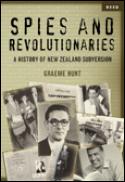Graeme Hunt Authors Book on New Zealand Spies and Revolutionaries
Scoop is serializing the first 1000 words of each chapter of author Graeme Hunt's latest book: Spies And Revolutionaries – A History of New Zealand Subversion. Click here for Chapter One: Murder in a country churchyard
 The history of New Zealand's intelligence agencies and
those it has spied on have been laid bare in a book by
Auckland-based journalist, author, and historian Graeme
Hunt.
The history of New Zealand's intelligence agencies and
those it has spied on have been laid bare in a book by
Auckland-based journalist, author, and historian Graeme
Hunt.
Spies And Revolutionaries – A History of New Zealand Subversion details how several prominent New Zealanders, all of whom are dead, spied for the former Soviet Union during the Cold War. Accusations and suspicions are laid bare before files and information that has never before been made public. This book will clearly recharge debate as to whether Dr Bill Sutch, diplomat Paddy Costello, and public servant Ian Milner were spies acting against New Zealand's national interest.
Hunt is firm in his resolve: "It is high time we called these people the traitors they are… People make light of the corrupting influence of the Soviet Union on New Zealand life, but Russian communism attracted friends in government departments, universities, and the unions with several committed to establishing a communist state here."
Spies and Revolutionaries is the first national history of espionage and revolutionary activity in New Zealand. It starts with the death of the Rev. Carl Volkner at Opotiki in 1865. He was murdered by his Maori congregation who considered him a government spy.
The book covers Russian scares, Fenian riots, politically inspired strikes, the 1981 Springbok rugby tour, and the peace and anti-conscription movements.
There is an account of French agents on New Zealand soil and their role in the sinking of the Rainbow Warrior in 1985. The behaviour and status of Algerian refugee Ahmed Zaoui also features prominently.
Hunt says this book gave him the opportunity to research the history and development of the New Zealand Security Intelligence Service and the civilian spy services that existed before it. Much of his research is drawn from recently released SIS files, many of which have not before been made public.
CHAPTER ONE: Murder in a country churchyard
 At
midnight on 19 October 1989 the remains of a Maori
rangatira, Mokomoko, and four colleagues were exhumed at Mt
Eden Prison in Auckland and returned to their descendants in
the eastern Bay of Plenty. It was the culmination of a
three-year campaign by the New Zealand Maori Council to have
the bodies exhumed. The council claimed it was against Maori
protocol for them to remain in unmarked graves in the jail
precincts. The exhumations were also a prelude to a Treaty
of Waitangi settlement between eastern Bay of Plenty iwi and
the Crown to end a grievance dating back to the nineteenth
century.
At
midnight on 19 October 1989 the remains of a Maori
rangatira, Mokomoko, and four colleagues were exhumed at Mt
Eden Prison in Auckland and returned to their descendants in
the eastern Bay of Plenty. It was the culmination of a
three-year campaign by the New Zealand Maori Council to have
the bodies exhumed. The council claimed it was against Maori
protocol for them to remain in unmarked graves in the jail
precincts. The exhumations were also a prelude to a Treaty
of Waitangi settlement between eastern Bay of Plenty iwi and
the Crown to end a grievance dating back to the nineteenth
century.
Missing from the exhumations, which were approved by Justice Minister Bill Jeffries, were the remains of Kereopa Te Rau, whose fiery teachings led to the grisly murder of the German-born missionary Carl Völkner, in Opotiki in March 1865. Kereopa’s remains are in an unmarked grave in the grounds of the former Napier Prison, which closed in 1993 and has been a backpackers’ hostel since 2002. His reputation, like those of his fellow murderers, has been rehabilitated partly because of a widely held view that Völkner was a government spy.
But the Waitangi Tribunal, which heard various claims from eastern Bay of Plenty iwi in dispute with the Crown, said the murder of Völkner and that of James Fulloon, a half-caste interpreter and native agent in the government service, four months later, could not be justified and that the governor, Sir George Grey, was within his rights to hunt down the perpetrators and bring them to justice. Where the Crown erred, the tribunal found, was by visiting the sins of those who murdered Völkner and Fulloon on local iwi by confiscating large tracts of their lands. Throughout the 12 hearings, which lasted 16 months from July 1994 until November 1995, mention was made of Völkner’s alleged treachery and the right of the adherents of Pai Marire, the cult-like religion founded by Te Ua Haumene in 1862, to destroy all who crossed its path.
Völkner, in his mid-forties, made several trips from Opotiki to Auckland in 1864, keeping Grey informed of the growing tribal tension in the eastern Bay of Plenty. He also wrote letters to Grey about events in the region, not least the tensions in the local iwi, the Whakatohea, over whether East Coast tribes should support the Maori insurrection in Tauranga and the Waikato. One letter contained a map of Rangiaowhia pa near Te Awamutu, where Kereopa’s wife and two daughters had allegedly been killed by British troops in February 1864. From mid-February 1865 Völkner had the added challenge of seeing his Maori congregation come under the influence of the Pai Marire movement with the arrival in Opotiki of Kereopa and Patara Raukatauri to spread the teachings of Te Ua throughout the East Coast.
Völkner took his wife, Emma, to Auckland for safety but ignored warnings from his flock to stay away from Opotiki. He arrived home with another missionary, Thomas Grace, on the schooner Eclipse on 1 March 1865. (Grace had been forced to abandon his station at Pukawa, Lake Taupo.) Völkner’s house had been plundered in his absence and he and Grace were taken prisoner by Hauhau,1 the fanatical adherents of Pai Marire, who now seemed to control his congregation.
Grace was held hostage for possible exchange with a rangatira of Ngaiterangi, who had been captured by the Ngati Pikiao hapu of Arawa while attempting to join the Hauhau. But Völkner had no such bargaining chip. The following day he was brought before Kereopa in St Stephen’s Church, which his once-loyal Opotiki congregation had built for him and which he had consecrated a year earlier. After a ‘trial’ lasting a minute or so, Völkner received the death sentence and was stripped of his coat and waistcoat (which Kereopa put on) before being led outside to a large willow tree. After praying and shaking hands with his captors, he was hanged with tackle stolen from the Eclipse. It was a botched affair and his body was hauled up and down several times before he was eventually shot. After about an hour the body was taken to a spot near the church where the head was cut off and frenzied Hauhau crowded round to catch the blood, drink it and smear it on themselves. Kereopa, while he was not technically part of the hanging party, filled a communion chalice with Völkner’s blood and carried it with the head into the church with Hauhau following behind in procession.
According to James Cowan, the most eminent of the Land Wars’ historians, it was as if ‘a devil had entered into the people’2 with Kereopa leading the depraved proceedings. His next step was to gouge the eyes from the severed head and eat them one at a time, announcing that one eye was for the Parliament of England and the other for the law of New Zealand. The second eye stuck in his throat in what would be seen as an aitua –– a bad omen –– and a portent of death and he needed water to swallow it. He then led the congregation in communion, using the chalice containing Völkner’s blood.
Kereopa’s barbaric act earned him considerable mana and the nickname ‘Kaiwhatu’ (‘Eye-eater’). He was said to have been motivated by a hatred of missionaries, of Governor Grey, the extension of British law, and by utu for the alleged killing by British troops of his wife and daughters at Rangiaowhia. Whatever the reasons for Kereopa’s action, Völkner’s martyrdom and the murder of Fulloon in Whakatane in July that year sent shockwaves through the settler community and led to heated calls from settlers for reprisals. Hauhauism was portrayed as far away as London as a fanatical, violent religion despite there being no instructions from its prophet, Te Ua, to murder missionaries. It was made worse by the fact that Völkner’s severed head was preserved and taken by Kereopa around the North Island as a battle trophy.
Völkner’s alleged spying, which has been raised over the years as justification for his murder, was probably no more than the actions of an honest citizen keeping the government abreast of a tense situation.
Scoop is serializing the first 1000 words of each chapter of author Graeme Hunt's latest book: Spies And Revolutionaries – A History of New Zealand Subversion.
SRP: $29.99 ISBN: 9780790011400 340p, includes index, black and white photos Reed Publishing (NZ) Ltd www.reed.co.nz Release: August 6 2007 For more, see… Reed Publishers, Spies And Revolutionaries



 Eugene Doyle: Writing In The Time Of Genocide
Eugene Doyle: Writing In The Time Of Genocide Gordon Campbell: On Wealth Taxes And Capital Flight
Gordon Campbell: On Wealth Taxes And Capital Flight Ian Powell: Why New Zealand Should Recognise Palestine
Ian Powell: Why New Zealand Should Recognise Palestine Binoy Kampmark: Squabbling Siblings - India, Pakistan And Operation Sindoor
Binoy Kampmark: Squabbling Siblings - India, Pakistan And Operation Sindoor Gordon Campbell: On Budget 2025
Gordon Campbell: On Budget 2025 Keith Rankin: Using Cuba 1962 To Explain Trump's Brinkmanship
Keith Rankin: Using Cuba 1962 To Explain Trump's Brinkmanship